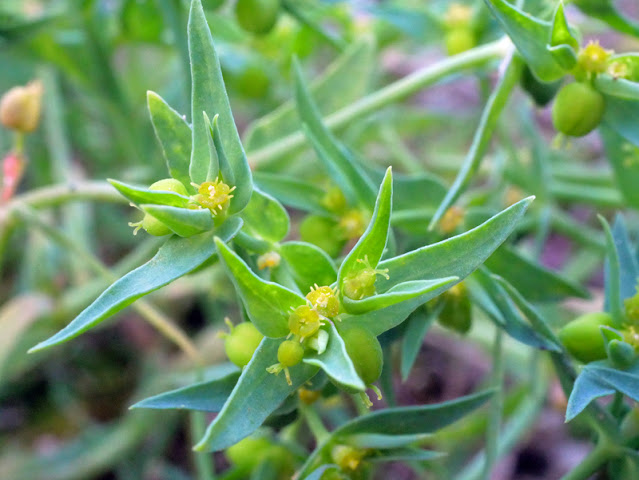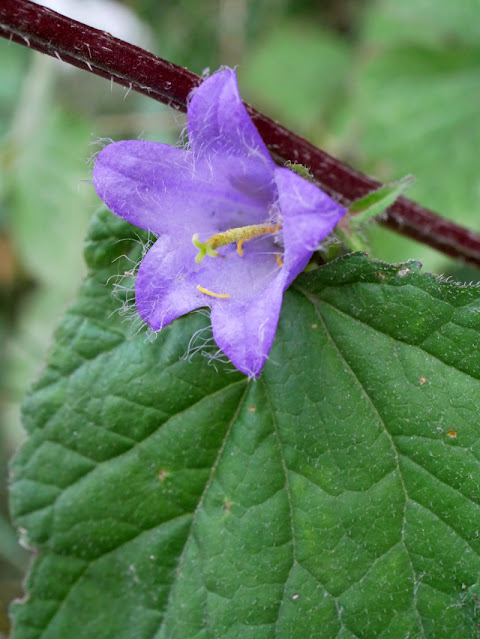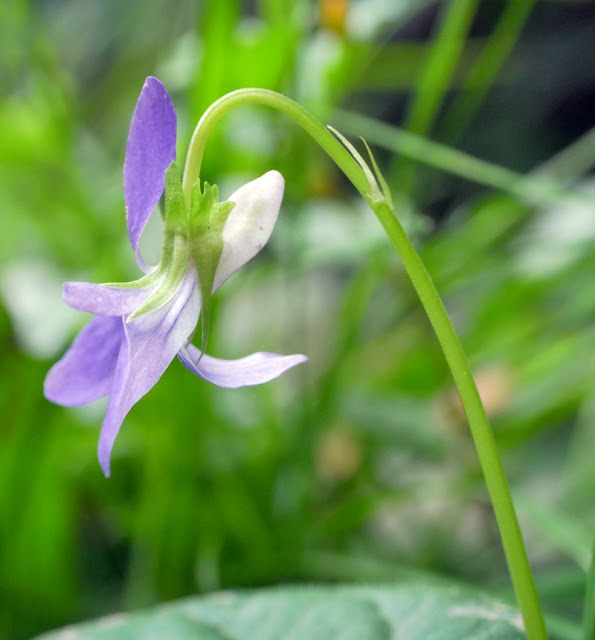Autumn 2021 - Botanical Finds from Kent
This is the last blog for 2021 for my Kent trips and covers September to mid November.
First up is a recording trip I made to a rural road and adjacent fields near Upper Halling. This had a wonderful roadside flora given it was on chalk and mostly untouched by mowing, sprays and fertilisers.
It didn't take long to find my first rare species, Dwarf Spurge, a lover of chalky fields. It's low growing with quite small pointy leaves, so it stands out as different to other Spurges. You will likely only find it on disturbed alkaline soils too.
Euphorbia exigua
Here's what you would see from a standing height.
Three Toadflax species were nearby, Round and Sharp Leaved Fluellens with their tiny but exquisite flowers and Common Toadflax too. The photo is of Round-leaved Fluellen.
Kickxia spuria
A surprise find was several metres of roadside verge covered in Meadow Cranesbill. I think these likely came from fly tipped garden material as they are pretty much absent in the wild in Kent.
Geranium pratense
Another lovely big and blousy blue flower on display was the Nettle-leaved Bellflower. This is quite a common plant found along the chalk verges from Wrotham Hill to the Medway Gap area. The one below was photographed in September, but I did find one still flowering in mid November near Wrotham Hill too, although to be fair, a recent mowing had stimulated the plant to throw up more flowers. The flowers are quite large, usually at least an inch across, so I'm surprised these haven't made it into gardens really.
Campanula trachelium
Here is a view of the rural road verge. Arable to the left and wild to the right where an old quarry had plants such as Carline Thistle and Wild Strawberry. Assorted Goosefoots and Oraches were on and around the manure heap in the image and the meadow cranesbill were on the left verge in the foreground. All with beautiful downland views too.
A few days later and I was walking along an arble field path near Cobham and found some surprise Jersey Cudweed plants. It was a surprise because this was found in an arable field and not in street pavement cracks or block paving where it is usually found in Kent. This is the second place I have found them in a rural setting now, indicating a rapid expansion. It will likely soon be removed from the Kent RPR as it becomes more common.
Laphangium luteoalbum
Florets/seedheads
Leaves showing the silvery hairs all over the stem and leaves.
Its now the 10th September and I am recording a rural lane near Borough Green. By a horse paddock I find what seemed to be a tree mallow but with common mallow flowers. The flowers were very large and the leaves an odd shape. It turned out to be a Garden Tree Mallow, no doubt originating from more fly tipped material. It was entwined within native hedgerow plants and there were no indications it had been planted and no habitation was nearby either.
Malva olbia x thuringiaca = M x clementii
This trip gave me several records of planted rare wildflowers such as Cornflower, Corncockle and Corn Marigold along with Shasta Daisies. These were all on a sown wildflower strip along an arable field. In amongst it were more usual wildflowers such as Bladder Campion, Wild Marjoram and Yarrow. Anything I recorded here I gave a status as planted for the record I had found. If these later spread into the wild, at least my record will show their origins. Here's a Cornflower from that strip.
Centaurea cyanus
Nearby was a brownfield site which gave up a plethora of good records, this photo includes a few including a beautiful flowering specimen of Great Mullein.
Verbascum thapsus
"Wow" was my first thought when I came across Crimson Clover. It is a striking plant and cannot be missed when in flower. However, it is not native so one must look to see why it has appeared in a field edge. In this case, it was clear it was part of a seed mix for a wildflower strip to an adjacent arable field. This one contained completely different species to the one above, but one of the giveways is that the same species occur in a strip along a field edge and nowhere else. Again, I recorded these as planted. Nice to see though.
Trifolium incarnatum
Here is that wildflower strip. Quite a big one too, but not very diverse in species.
The most unusual plant found nearby and not part of the sowing, was a Marsh Woundwort. It was unusual as this was growing on chalk in the Downs and not by water. However, I did note it was on a North facing woodland edge that was very damp. Needless to say I checked to see if it was the hybrid, but it lacked the stalked leaves and the flowers looked good for Marsh too.
Stachys palustris
Its now mid September and I did a short walk around a rural area near an oddly named village called Crouch. This area had acid soils and a completely different flora to that found in the previous areas above. I found the beautiful but rare in Kent, Bell Heather. Ive only seen it (in Kent) at Pembury Walks and here. It can be told apart from Cross-leaved Heath in that the leaves are in whorls of three and not four. You can easily see these whorls in the first photo.
Erica cinerea
These tiny flowers below are from Trailing St John's Wort and are about 1/2" across. They are surprisingly easy to miss as the leaves are small and as their name suggests, they trail across the woodland floor. They like recently coppiced areas and woodland paths where competition isn't too fierce.
The larger leaves in the foreground belong to Yellow Pimpernel and the upright green stalks to Smooth Rush. I really like the small plants found along woodland paths.
Hypericum humifusum
Here's another plant from a different woodland, Kingswood near Kingshill. This better shows the leaf arrangement on this small plant.
I was surprised to find some areas of Mereworth Woods under recorded. So I thought I'd put that right and filled in the gaps. Of course, two of the monads contained new records of the dreaded Piri Piri Bur from New Zealand. It apparently arrived here in WWII when ANZAC troops garrisoned in the woods. Look at the arrowheads on their seeds! It pierces your clothing and then transfers to it, so any human or animal with fur is likely to disperse it far and wide. Also known as a sock destroyer by hikers.
Be careful not to help it spread won't you! If you pick up seeds in your clothing, burn them.
Acaena novae-zelandiae
Below is the Common Hemp Nettle. It's been a bad year for it as this is the only plant I've found this year. All the others found have been the Bifid Hemp Nettle. Lovely plant, but the calyxes are quite sharp and can pierce skin, so be careful if handling it.
Galeopsis tetrahit
I don't often find this plant, which is Heath Groundsel, but it was present in large numbers in Mereworth Woods in some places. Unlike normal Groundsel, it is often over two feet tall, nowhere near as hairy and the flowers usually have small rays that curl out and inwards as shown.
Senecio sylvaticus
I had no idea what this caterpillar was. However, I knew what plant it was on and used this knowledge to help ID it. It's a Figwort Saw-Fly caterpillar, on a Water Figwort plant of course.
In the distance lies the chalk of the North downs at Wrotham Hill, as seen from Mereworth Woods.
It used to be a revelation finding a Spring flowering Violet in flower in the Autumn, but no more. In fact, they have flowered a lot this Autumn, almost always in woodlands with plenty of light. I've seen Early or Wood Dog Violet and Sweet Violet in flower and this Common Dog Violet below. I look forward to the Spring to look for assorted hybrids between them too.
Viola riviniana
Mid October and I find some flowering Water Chickweed by the moored boats at Nettlestead on the River Medway. This is the only chickweed with purple anthers and it also has large flowers. True to its name it was actually growing in the water.
Now re-named as:
Stellaria aquatica
My last trip was in late November and was more of a walk than a recording trip. At this time of the year one notices things other than wildflowers! The beautiful shed leaves of a Field Maple, a lovely looking native tree. In comparison, the dull brown leaves of English Oak (Quercus robur) lie next to them.
Acer campestre
Wild Basil and Wild Carrot were still flowering along a field edge.
Clinopodium vulgare
Daucus carota ssp carota
I could have easily seen this and thought, "oh, another Wild Carrot" but the drooping bracteoles underneath show this to be Fool's Parsley, a common arable plant in flower in later Summer onwards.
Aethusa cynapium
This time of the year and over Winter is when one starts to appreciate the more common wildflowers. Here's a close up of Red Clover. You might even have this in your lawn. Let it flower and the bees will welcome it (and little spiders).
Trifolium pratense
We are moving to Cornwall in February 2022, so as we say goodbye to Kent, a new dawn will begin there with a host of different wildflowers to find. I'm looking forward to it, though I will greatly miss the flora of the South East. Kent and East Sussex, as both have an amazingly varied flora. The variety of habitats and soil types allows a huge diversity of species to co-exist in a small area. Not to mention that Kent alone probably has the most varied and numerous species of wild orchids in the UK too.
Mind you, I won't miss watching them being destroyed with development, neglect or intensive agriculture. Several sites have disappeared under concrete in just one year where I currently live.
However, there is still the New Year Plant Hunt coming this next weekend. See https://bsbi.org/new-year-plant-hunt for details.
Have a great New Year. I don't think it could be much worse than the last 2 years, can it? I'll leave you with some soon to come Spring flowers.
Kind Regards
Dave



































Hello David ,
ReplyDeleteWe haven,t met , but i,ve been an avid follower of your excellent blog for several years now and i,ve
a lot to thank you for ,having learnt so much from your posts.
I,ve always had a passing interest in our Kentish flora ,more so since following your posts and i must confess to "twitching " some of the unusual species that you,ve posted ,finally adding (this year ) a much wanted species ie;Wood Vetch in Covert Wood , .I shall very much miss your Kent posts ,but hope you continue down in Cornwall , we found some brilliant plants while visiting the Lizard there last couple of years ,including the glorious Western Ramping Fumitory .
Anyway i wish you well with your move .and hope you,re happy down in Cornwall.
Kind regards Allan Ward.
New blog for Cornwall is at
ReplyDeletehttps://sylvatica2022.blogspot.com/
Regards Dave